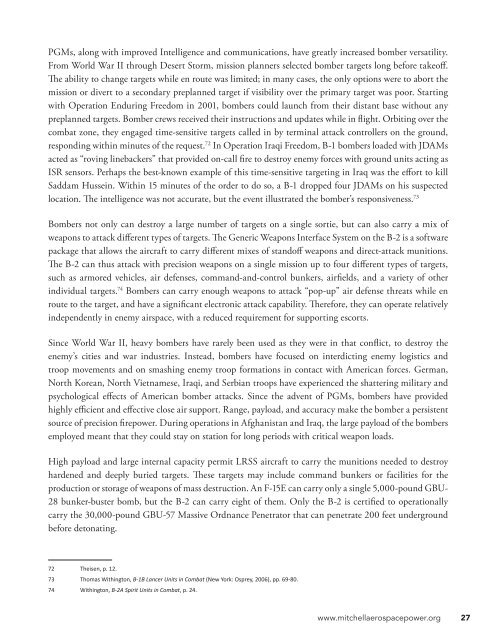Create successful ePaper yourself
Turn your PDF publications into a flip-book with our unique Google optimized e-Paper software.
PGMs, along with improved Intelligence and communications, have greatly increased bomber versatility.<br />
From World War II through Desert Storm, mission planners selected bomber targets long before takeoff.<br />
The ability to change targets while en route was limited; in many cases, the only options were to abort the<br />
mission or divert to a secondary preplanned target if visibility over the primary target was poor. Starting<br />
with Operation Enduring Freedom in 2001, bombers could launch from their distant base without any<br />
preplanned targets. Bomber crews received their instructions and updates while in flight. Orbiting over the<br />
combat zone, they engaged time-sensitive targets called in by terminal attack controllers on the ground,<br />
responding within minutes of the request. 72 In Operation Iraqi Freedom, B-1 bombers loaded with JDAMs<br />
acted as “roving linebackers” that provided on-call fire to destroy enemy forces with ground units acting as<br />
ISR sensors. Perhaps the best-known example of this time-sensitive targeting in Iraq was the effort to kill<br />
Saddam Hussein. Within 15 minutes of the order to do so, a B-1 dropped four JDAMs on his suspected<br />
location. The intelligence was not accurate, but the event illustrated the bomber’s responsiveness. 73<br />
Bombers not only can destroy a large number of targets on a single sortie, but can also carry a mix of<br />
weapons to attack different types of targets. The Generic Weapons Interface System on the B-2 is a software<br />
package that allows the aircraft to carry different mixes of standoff weapons and direct-attack munitions.<br />
The B-2 can thus attack with precision weapons on a single mission up to four different types of targets,<br />
such as armored vehicles, air defenses, command-and-control bunkers, airfields, and a variety of other<br />
individual targets. 74 Bombers can carry enough weapons to attack “pop-up” air defense threats while en<br />
route to the target, and have a significant electronic attack capability. Therefore, they can operate relatively<br />
independently in enemy airspace, with a reduced requirement for supporting escorts.<br />
Since World War II, heavy bombers have rarely been used as they were in that conflict, to destroy the<br />
enemy’s cities and war industries. Instead, bombers have focused on interdicting enemy logistics and<br />
troop movements and on smashing enemy troop formations in contact with American forces. German,<br />
North Korean, North Vietnamese, Iraqi, and Serbian troops have experienced the shattering military and<br />
psychological effects of American bomber attacks. Since the advent of PGMs, bombers have provided<br />
highly efficient and effective close air support. Range, payload, and accuracy make the bomber a persistent<br />
source of precision firepower. During operations in Afghanistan and Iraq, the large payload of the bombers<br />
employed meant that they could stay on station for long periods with critical weapon loads.<br />
High payload and large internal capacity permit LRSS aircraft to carry the munitions needed to destroy<br />
hardened and deeply buried targets. These targets may include command bunkers or facilities for the<br />
production or storage of weapons of mass destruction. An F-15E can carry only a single 5,000-pound GBU-<br />
28 bunker-buster bomb, but the B-2 can carry eight of them. Only the B-2 is certified to operationally<br />
carry the 30,000-pound GBU-57 Massive Ordnance Penetrator that can penetrate 200 feet underground<br />
before detonating.<br />
72 Theisen, p. 12.<br />
73 Thomas Withington, B-1B Lancer Units in Combat (New York: Osprey, 2006), pp. 69-80.<br />
74 Withington, B-2A Spirit Units in Combat, p. 24.<br />
www.mitchellaerospacepower.org 27


